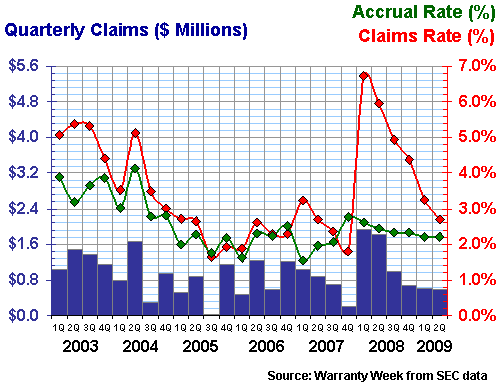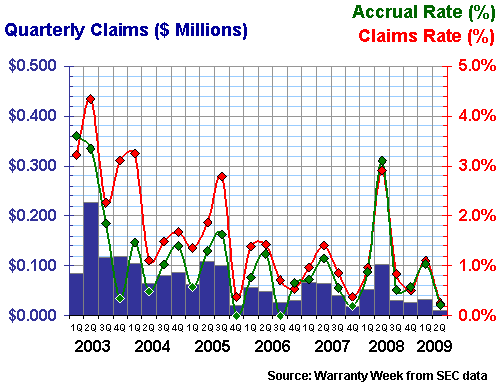Telecom Equipment Warranties:Though industry sales are down in general, a handful of telecommunications, data networking and broadcast equipment manufacturers have managed to reduce their warranty costs and increase their sales at the same time. But as dramatic as some of the recent cost reductions are, the companies rarely mention either the cause of the initial problem or how they solved it.
Warranty cost reduction, it would seem, is not a topic a typical manufacturer wants to discuss in polite company. It's like kicking a bad habit or giving up on a life of crime: they think the mere announcement of the cure will draw attention to the fact that there used to be a problem.
Among the nearly 100 telecom equipment vendors whose warranty costs we track, several have recently cut their warranty costs from near-crisis levels. Some also managed to increase their product sales at the same time. And not one made the slightest mention of either the elevated warranty costs nor the reductions in any of their financial statements or press releases.
Falling Claims
Claims reported by telecom equipment manufacturers in the first half of 2009 added up to $740 million, but that amount was significantly below the $773 million reported by the same companies during the same period in 2008. As a quick peek at Figure 1 confirms, both the first quarter and the second quarter figures for 2009 were significantly below their year-ago values. In fact, the second quarter of 2009 saw the lowest amount of claims reported since the middle of 2003.
Figure 1
U.S.-based Telecom Equipment Manufacturers
Warranty Claims Paid per Quarter, 2003-2009
(in US$ millions)
Low claims totals are usually a good sign, except when they have more got to do with falling sales than with rising product quality. Products don't need repairs if they're not sold. And in this, the final year of the Great Recession, falling sales have had a massive impact on the need for repairs. One way to measure this is to compare claims to sales totals, calculating what percentage of revenue is spent on warranty work.
Reversing Past Cost Reductions?
In Figure 2, we have taken the claims totals from Figure 1 and compared them against sales. The result is the upturn in the red line, which shows the claims rate jumping in 2009 from its relatively low levels of 2008. The industry's claims rate in June 2009 was 1.6%, up from only 1.3% in June 2008. While that's a big jump for just one year, the 1.6% level isn't all that different from the figures seen in 2005 and 2006. In other words, what the recession has done in this industry is to reverse much of the cost reduction progress seen in 2007 and 2008.
Figure 2
U.S.-based Telecom Equipment Manufacturers
Industry Average Claims and Accrual Rates, 2003-2009
(as a percentage of product sales)
The year-ago comparisons will look even worse once the third quarter 2009 numbers come in, and the new average is compared to a record low claims figure from 2008. In addition, while the accrual rates haven't changed as much as claims have in the past year, the middle of 2008 also set a new low mark for that metric. We added a trend line to make the pattern clear.
Sales were better in 2008 for most of these companies, and the sales declines seen so far in 2009 accounted for much of the changes seen in the percentages of Figures 1 and 2. Of the 98 telecom equipment companies for which first half 2008 and 2009 sales figures could be compared, 76 saw sales declines. However, that means 22 companies saw sales increases. And some of them also saw their warranty costs decline.
Cutting Warranty Costs
Four of the six companies selected for snapshots below are among those 22 to see sales increases. That was unintentional. We were actually looking for companies that had cut their warranty costs in recent years. The sales increases were secondary. However, just as sales declines can raise the percentages, sales increases can help reduce them. So there is something of a correlation between them. But it's not automatic: only eight of the 22 saw their claims rate fall and only 12 out of the 22 saw their accrual rate fall.
Only six of the 22 saw both their claims rate and accrual rates fall. However, three of those lucky six are represented by snapshots below: 3Com Corp.; Sycamore Networks Inc.; and Giga-tronics Inc. For the sake of those who need to know the identity of the other three lucky companies, they are Applied Signal Technology Inc.; Symmetricom Inc.; and Blue Coat Systems Inc.
We suspect that if these companies had their way, none of this seemingly good news would ever be reported anywhere. The sales increases -- yes, those are widely mentioned in the financial press, along with net income and earnings per share. But warranty cost reductions? Giving publicity to that metric could possibly make people think that quality used to be bad, but now it's better. And since the companies never mentioned that quality used to be bad, they aren't in any rush to announce it's better now.
Steady Multi-Year Cost Reductions
Data networking leader 3Com almost didn't make it into this select camp of telecom equipment providers that saw claims and accrual rates fall while sales rose. But as Figure 3 suggests, it's not because of a lack of movement by the claims or accrual percentages. Instead, 3Com almost missed the list because product sales were up by only 1.3% in the fiscal year ended May 31, 2009. Still, in this economy, even a slight increase is something to celebrate.
During this most recent fiscal year, the company's claims rate fell from 3.0% to 2.5%, while its accrual rate fell from 2.7% to 1.9%. So the multi-year downward slope in the data seen in Figure 3 continues into a fifth, and hopefully a sixth consecutive year.
Figure 3
3Com Corp.
Warranty Claims & Accrual Rates, 2003-2009
(as a percentage of product sales)
For 3Com, warranty costs are now well below their 2003-2004 peak. In dollar terms, warranty claims have fallen from $47 million in fiscal 2007 to $37.7 million in fiscal 2008 and then to $31.2 million in fiscal 2009. Accruals actually fell a bit faster, from $46.4 million in 2007 to $23.9 million in fiscal 2009.
It's hard to believe this is the same company that paid out nearly 6% of its product revenue for warranty work only five years ago. But what 3Com seems to have done somehow is to find a way to grow sales without increasing warranty costs. In the final quarter of 2004, the company spent $7.6 million on warranty claims, and that amount represented 5.6% of its hardware revenue. In the second quarter of 2009, the company still spent $7.6 million on warranty claims, but it represented only 2.5% of hardware revenue.
Recovering from a Warranty Trauma
Cobra Electronics is another company that has recovered nicely from a warranty trauma. But as Figure 4 illustrates, it's even more recent history for this well-known manufacturer of CB radios, radar detectors, GPS navigation systems, and cell phone accessories. In the first quarter of 2008, Cobra paid out an astounding $1.9 million in claims on $28.9 million in revenue, for a 6.7% claims rate. By the first quarter of 2009, sales had fallen to $19.1 million, but claims fell to $621,000. So the claims rate was down to 3.3%. By June 2009, it had fallen all the way to 2.7%.
Figure 4
Cobra Electronics Corp.
Warranty Claims & Accrual Rates, 2003-2009
(as a percentage of product sales)
High warranty costs have plagued numerous other makers of sophisticated hand-held electronics, such as Palm Inc. and Garmin Ltd. And in six of the past 26 quarters, Cobra Electronics has seen its warranty claims cost rise above the 5% line. But for at least the past five quarters, the trend has been in the downward direction. And hopefully, warranty costs will stay low from now on.
Another Warranty Trauma
Sycamore Networks was one of the companies we featured in the last half-year report on telecom equipment warranties, in the October 9, 2008 newsletter. At that time almost exactly a year ago, the optical switching equipment maker had just seen its claims rate jump to 12.5% while its accrual rate was raised to an incredible 16.6%.
Imagine that: in that one spectacularly bad quarter, the company set aside $2.4 million out of the $14.3 million it reported in product sales. That was triple the year-before level, and fortunately for Sycamore, has turned out to be its highest level ever. In the second quarter of 2009, accruals fell all the way to $154,000, while product sales were up to $15.6 million. Whatever caused the warranty trauma is apparently now history.
Figure 5
Sycamore Networks Inc.
Warranty Claims & Accrual Rates, 2003-2009
(as a percentage of product sales)
Ironically, most companies are just as silent about their recoveries from warranty cost traumas as they are about the actual spikes themselves. Sycamore Networks is no exception. There was no mention of a problem when warranty accruals consumed more than one-sixth of product revenue. And there was no mention of the year-later improvement, even in a section explaining the reasons behind the 5% jump in gross margins seen during the past year.
Follow the Bouncing Ball
Giga-tronics, our next candidate for a warranty snapshot, would do us all a favor if they would simply explain what the method is behind their warranty methodology. As can be seen in Figure 6, the trend is good but the constant bouncing around makes one wonder if there's any logic to the amounts set aside as warranty accruals each quarter.
Figure 6
Giga-tronics Inc.
Warranty Claims & Accrual Rates, 2003-2009
(as a percentage of product sales)
Giga-tronics is also in the telecom switching sector, but its specialty is in the microwave realm rather than in optical switches. Customers use its products in both the telecommunications and the aerospace industries, for both civilian and military communications applications. It has achieved both ISO 9001 quality certification and the aerospace-specific AS9100 certification level. But still, its warranty claims and accrual levels look like a pair of rubber balls bouncing down the stairs.
Recently, Giga-tronics has seen its claims rate dive from 2.9% to 0.2% from June 2008 to June 2009. Accruals fell from 3.1% of revenue to 0.2% of revenue. And revenue actually grew 28% during the period, from $3.5 million to $4.5 million. But, as with Sycamore Networks, Cobra, and 3Com, Giga-tronics is a bit shy when it comes to proclaiming a victory over rising warranty costs.
Reversing Rising Warranty Costs
Network Equipment Technologies never really had very high warranty costs, in either dollar or percentage terms. As can be seen in Figure 7, its quarterly warranty costs never surpassed $100,000, and they never exceeded half a percentage point's worth of product revenue. Simply put, the company's traditional markets of Internet voice and broadband networking don't throw off a lot of warranty expense.
NET has, however, seen its own warranty costs spike and plummet. The spike came in 2005 and again in 2006, when NET's claims rate rose to 0.48%, fell back, and then rose again to 0.44%. But that seems to have had more to do with a dip in sales than with a rise in claims.
The plummet began three years ago, when the claims rate quickly fell past 0.3%, then 0.2%, and then 0.1%. The claims rate stayed low for most of the past two years, though it briefly rose above 0.1% earlier this year before quickly falling back again.
Figure 7
Network Equipment Technologies Inc.
Warranty Claims & Accrual Rates, 2003-2009
(as a percentage of product sales)
Accruals have followed a similarly-shaped ski jump pattern, though the peaks were greater in 2003 and 2006 than in 2005. As of the end of June 2009, the company's accrual rate was down to 0.01%, even lower than the 0.03% rate seen a year before. And again, no reason was given for the spike, nor for the fall.
Saying Nothing About Warranty
AltiGen is also deep into the Internet voice and broadband networking business, though its warranty costs have usually consumed a significantly higher share of product revenue than is the case at NET. From 2004 until 2008, claims averaged 1.0% to 1.3% of revenue, while accruals were more in the range of 0.8% to 1.1% of revenue.
And then in 2009, claims first rose to 1.4% before falling below 0.2%. Accruals kept falling, first below 0.8%, and then below 0.7%. And, like its peers, the company said nothing about the cause of its good fortune.
Figure 8
AltiGen Communications Inc.
Warranty Claims & Accrual Rates, 2003-2009
(as a percentage of product sales)
AltiGen is one of the smallest warranty providers we've ever profiled in a snapshot like this. Its warranty claims total for the quarter ended June 30 were reported at only $6,000, and its hardware sales were only $3.56 million. In its latest financial report, it stated, "We have historically experienced minimal warranty costs." But even at these low levels, warranty is a process the company needs to manage. And whatever the cause of the drop, something is driving AltiGen's warranty costs down. Let's hope the trend continues, not only for them but for each of the others as well.
| 















